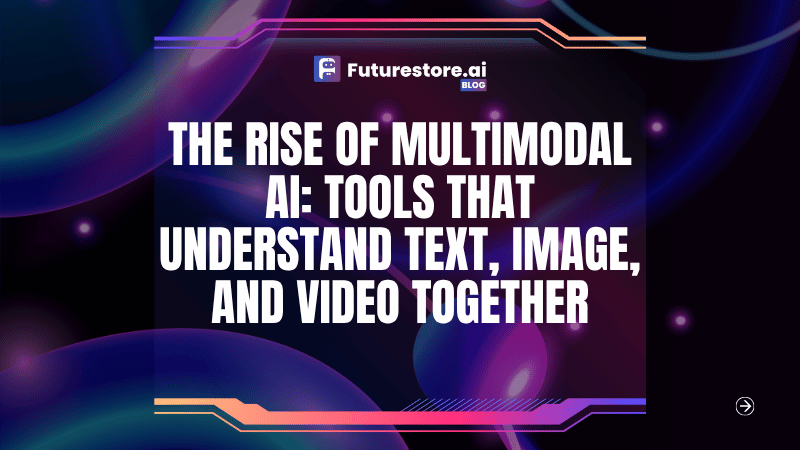1.Introduction: A New Age of Understanding
For years, AI could understand text, or analyze images, or recognize speech but never all at once. Now, Multimodal AI is here to change that. Imagine asking an AI to describe a meme, analyze a chart, summarize a YouTube video, or help edit a reel all in one conversation. This isn’t sci-fi anymore; it’s reality in 2025.
The rise of multimodal AI tools is breaking down the barriers between language, vision, and audio. These systems are trained to see, read, listen, and respond just like a human but with the power and speed of machines.
2.What Are Multimodal AI Tools?
Multimodal AI tools are systems that can process multiple forms of data simultaneously:
- Natural Language (Text)
- Visual Data (Images)
- Motion (Videos)
- Sound (Audio & Speech)
These tools rely on transformer-based neural networks and cross-modal training to build a unified understanding across different input types.
For a technical breakdown, visit:
The Illustrated Transformer
What Are Vision-Language Models? (Microsoft)
3.Top Multimodal AI Tools in 2025
OpenAI GPT-4o
The first real-time multimodal AI capable of processing text, image, and audio instantly. It can hold a conversation about a diagram, narrate a meme, or help with math from a photo.
Google Gemini 1.5 Pro
A powerful multimodal model integrating text, images, documents, and code. It’s designed to outperform even GPT-4o in reasoning tasks.
Meta’s LLaVA
A large vision-language model trained to handle complex image-caption tasks and open-ended visual conversation.
Runway ML Gen-3
Pioneering text-to-video AI that empowers creators to generate cinematic content from prompts.
Sora by OpenAI
A text-to-video model that allows you to create realistic videos from just a prompt.
Used for AI-driven video editing and generation, merging visuals and audio based on text or script inputs.
4.What Makes Multimodal AI Tools Special?
Unlike traditional AI that focuses on one type of input (like only text or images), multimodal AI tools combine language, vision, sound, and even motion into a single response system. This leads to:
- Richer context
- Faster responses
- More accurate outputs
- A more human-like understanding of the world
MIT Multimodal Learning Paper
5.Applications of Multimodal AI Tools
Education
- Convert handwritten notes into narrated videos
- AI tutors that can explain a diagram or chemistry equation
- Read-aloud image books for kids or language learners
Explore:
Khan Academy + GPT-4 Integration
Quizlet Q-Chat AI Tutor
E-commerce
- Auto-generate product descriptions from images
- Review analysis from text and photo uploads
- Virtual fitting room using real-time AI vision
Explore:
Shopify Magic (AI Tools)
Amazon Rekognition (Visual Analysis)
Content Creation
- Turn scripts into short films
- Auto-caption videos with contextual image understanding
- Social media post generators from mixed inputs
Explore:
Healthcare
- Combine radiology scans and text notes for diagnosis
- Voice interaction with medical charts
- AI-powered surgical training with video walkthroughs
Explore:
Google Med-PaLM 2
IBM Watson Health
6.Why Multimodal AI Is the Future
Multimodal AI tools are more than just an upgrade they redefine AI intelligence by replicating human-like perception.
- Smarter communication
- Context-aware responses
- Enhanced creativity
- Better decision-making
“AI that understands what you show and say is no longer next-gen, it’s now-gen.”
7. What’s Coming Next in Multimodal AI?
- Emotion-aware video assistants
- Full-sensory AR experiences
- Real-time language + image translation
- 3D scene understanding and generation
For predictions:
MIT Technology Review – AI Trends
- Emotion-aware agents using audio + facial analysis
- Multimodal search engines (text + image + voice)
- True AI assistants with humanlike interaction
Emerging areas include:
- Embodied AI for robotics
- Multilingual Multimodal AI for translation and diplomacy
- Augmented Reality with AI in real time
Google DeepMind Research
8.Conclusion
The age of Multimodal AI Tools has arrived and it’s more than a trend. It’s the foundation of a new digital era where interaction becomes more intuitive, intelligent, and inclusive.
From schools to studios, hospitals to headlines, these tools are reshaping how we create, communicate, and connect. If you’re not using them yet you will be.
9. Ready to Embrace Multimodal AI?
Start exploring the world of Multimodal AI tools and future-proof your skills and business today.
“The future isn’t just written . it’s visualized, narrated, and experienced. And Multimodal AI is your gateway there.”
Useful Resources to Dive Deeper:
- OpenAI GPT-4o Overview
- Google Gemini Project
- Meta FAIR Research
- Stanford Center for AI Safety
- AI21 Labs – Multimodal Capabilities
Check out : AI Agents vs Traditional Automation: A Comprehensive Comparison

